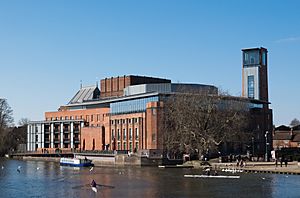Elisabeth Scott facts for kids
Elisabeth Whitworth Scott (born September 20, 1898 – died June 19, 1972) was a British architect. She is famous for designing the Royal Shakespeare Theatre in Stratford-upon-Avon, England. This was a very important building because it was the first major public building in Britain designed by a woman architect.
Contents
Early Life and Education
Elisabeth Scott was born in Bournemouth, England. She was one of ten children. Her father, Bernard Scott, was a surgeon. She came from a family of architects, including her great-uncles George Gilbert Scott and George Frederick Bodley. Her second cousin, Giles Gilbert Scott, designed Liverpool Cathedral.
Elisabeth was taught at home until she was 14. Then she went to Redmoor School in Bournemouth. In 1919, she joined the Architectural Association School of Architecture in London. She was one of the first students there and graduated in 1924.
Beginning Her Architecture Career
After graduating, Elisabeth Scott started working for different architects. Her first job was with David Niven and Herbert Wigglesworth, who designed buildings in the Scandinavian style. She also worked for Louis de Soissons, who designed modern buildings for the new garden city of Welwyn Garden City. There, she helped design the famous Shredded Wheat Factory. She also worked with Oliver Hill, a modernist architect.
Designing the Shakespeare Memorial Theatre
In 1927, a competition was held to design a new Shakespeare Memorial Theatre. The old one had burned down. Elisabeth Scott decided to enter the competition. She was working for Maurice Chesterton's firm at the time, and he helped check her ideas.
Elisabeth worked with two other students from her architecture school: Alison Sleigh and John Chiene Shepherd. They won the competition against 71 other designs! After winning, the four of them formed a team to create the detailed plans and oversee the building's construction.
Reactions to the Theatre Design
People had different opinions about Scott's design. Some thought the building looked too big and "monstrous" for the small town. However, The Times newspaper liked how well it fit with the river and landscape.
The famous composer Sir Edward Elgar was very unhappy with the design. He called it "unspeakably ugly" and refused to be involved with the theatre. But the playwright George Bernard Shaw strongly supported Scott's design. He felt it was the only one that truly understood what a theatre needed. Scott herself said she wanted the building's purpose to be clear in its design.
Inside the theatre, performers found it hard to connect with the audience at first. The large, plain walls seemed to distract people. This problem was fixed in 1951 when more seating was added along the sides. Despite some early criticism, many people praised the building for its simple, functional style.
Today, the theatre is called the Royal Shakespeare Theatre. It is seen as a very important building that shows the "best modern municipal style of architecture." It became a protected building (Grade II* listed) in 1980.
Later Architecture Projects

After the Shakespeare Memorial Theatre, Elisabeth Scott formed a new partnership with John Breakwell and John Shepherd and Alison Sleigh (who had married). Their later projects were not as famous as the theatre. However, their work on the Fawcett Building at Newnham College, Cambridge, in 1938, is notable.
After World War II, Scott moved back to Bournemouth. She worked with a local firm and later for the Bournemouth Borough Architect's Department. She helped with projects like the new Pavilion Theatre on Bournemouth Pier. While these projects were not as grand, she continued to work until she retired in 1968.
Breaking Barriers for Women
When Elisabeth Scott started her career in 1924, there were almost no well-known women architects. Her success in designing the Shakespeare Memorial Theatre was a huge step forward. She also made sure to hire other women architects to help her with the Stratford design whenever possible.
Elisabeth Scott was not a loud activist, but she was a practical feminist. She believed in showing that women could succeed in professions traditionally dominated by men. She worked with groups like the Fawcett Society to help women gain wider acceptance in different fields. More than anything, she wanted to be known simply as an 'architect,' not just a 'female architect.' She was also an active member of Soroptimist International of Bournemouth, a group that supports women.
Personal Life
In 1936, Elisabeth Scott married George Richards. She passed away in Bournemouth on June 19, 1972.
Recognition on UK Passport
In November 2015, it was announced that Elisabeth Scott would be one of only two important British women featured on the design of the new UK passport. The other woman was Ada Lovelace. This showed how much her contributions were valued.
Images for kids
See also
 In Spanish: Elisabeth Whitworth Scott para niños
In Spanish: Elisabeth Whitworth Scott para niños



